| Loudon Park Funeral Home and Cemetery | |
|---|---|
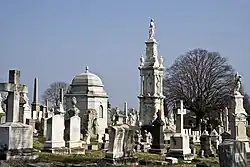 The central portion of the cemetery | |
| Details | |
| Established | 1853 |
| Location | |
| Country | United States |
| Coordinates | 39°16′54″N 76°40′47″W / 39.28167°N 76.67972°W |
| Type | Public |
| Owned by | Privately owned |
| Size | 500-acre (202 ha) |
| No. of interments | ~130,000 |
| Website | www |
| Find a Grave | Loudon Park Funeral Home and Cemetery |
Loudon Park Cemetery is a historic cemetery in Baltimore, Maryland. It was incorporated on January 27, 1853, on 100 acres (40 ha) of the site of the "Loudon" estate, previously owned by James Carey, a local merchant and politician.[1][2][3] The entrance to the cemetery is located at 3620 Wilkens Avenue.
The cemetery and Loudon Park Funeral Home, Inc. are locally owned and operated. Both the cemetery and the funeral home became privately owned in 2014 when they were acquired from Service Corporation International (SCI).[4] Loudon Park Funeral Home was built on the grounds of the historic cemetery by Stewart Enterprises in 1995.[5] SCI acquired Stewart Enterprises in 2013.[6]
Loudon National Cemetery
A portion of the eastern section is owned by the federal government as Loudon Park National Cemetery, acquired in 1861, and holds the remains of 2,300 Union soldiers[2] killed during the Civil War.[3] There is also a Confederate section where about 650 Confederate soldiers are buried,[2] marked by a statue of a Confederate soldier. Since 2003, nearly all of the Confederates in this section have had new markers put on their graves under an "Adopt-a-Confederate" program.[7] The entrance to the National Cemetery portion of Loudon Park is located along Frederick Avenue in the neighborhood of Irvington.
Notable persons
Notable persons interred here include:
- Charles J. Baker (1821–1894), ex officio Mayor of Baltimore[8]
- Thomas Beck (1909–1995), actor
- Charles Joseph Bonaparte (1851–1921), former United States Attorney General, former United States Secretary of the Navy, founder of the Federal Bureau of Investigation.
- Jerome Napoleon Bonaparte (1805–1870), son of Jérôme Bonaparte, nephew of Emperor Napoleon I, father of Charles Joseph Bonaparte.
- William Samuel Booze (1862–1933, U.S. Congressman from Maryland's 3rd District, 1897–1899
- Abel G. Cadwallader (1841–1907), Civil War Medal of Honor recipient.
- Jack L. Chalker (1944–2005), author
- Clarence Lemuel "Cupid" Childs (1867–1912), Major League Baseball Player.
- Barnes Compton (1830–1898), former Congressman and Maryland state Treasurer.
- Frederick Nicholls Crouch (1808–1896), composer.
- Elijah Cummings (1951–2019), U.S Congressman from Maryland's 7th district, 1996–2019.
- Frederick George D'Utassy (1827–1892), Civil War Union Army officer
- David Danforth (1890–1970), Major League Baseball player
- James William Denny (1838–1923), Civil War Confederate Army officer and U.S. Congressman for Maryland's 3rd District, 1899–1901 and 1903–1905
- Lewis Pessano "Buttercup" Dickerson (1858–1920), Major League Baseball player
- Charles W. Field (1828–1892), military officer in the United States, Confederate and Egyptian armies
- John T. Ford (1829–1894), operator of Ford's Theater
- James Albert Gary (1833–1920), 38th United States Postmaster General[9]
- Harry Gilmor (1838–1883), Confederate cavalry officer and Baltimore City Police Commissioner.
- William Henry Gorman (1843–1915), cofounder of Citizens Bank of Maryland
- Bradley T. Johnson (1829–1903), Writer, Confederate Brigadier General, commanded the 1st Maryland Regiment (C.S.A.).
- William Kimmel (1812–1886), U.S. Congressman for Maryland's 3rd District, 1877–1881.
- Frederic Arnold Kummer (1873–1943), American author, playwright and screenwriter[10]
- William W. McIntire (1850–1912), U.S. Congressman for Maryland's 3rd District, 1897–1899.
- H. L. Mencken (1880–1956), journalist, critic, author, and essayist.
- Ottmar Mergenthaler (1854–1899), inventor of the Linotype.
- Howard S. O'Neill (1883–1966), state senator and lawyer[11]
- J. Smith Orrick (died 1930), American politician[12]
- Mary Young Pickersgill (1776–1857), seamstress who made the flag flying over Fort McHenry during the Battle of Baltimore, inspiring Francis Scott Key to write "The Star-Spangled Banner".[13]
- Robert John Reynolds (1838–1909), former governor of Delaware.
- Samuel J. Seymour (1860–1956), the last surviving witness to the assassination of Abraham Lincoln.
- Frank S. Strobridge (1857–1918), American politician and insurance businessman[14]
- Alpheus Waters Wilson (1834–1916), bishop of the American Methodist Episcopal Church, South[15]
The Weiskittel-Roehle Burial Vault, faced with cast iron, was listed on the National Register of Historic Places in 1976.[16]
Images
 Funeral home, Wilkens Avenue
Funeral home, Wilkens Avenue Original main gate and office, Frederick Avenue
Original main gate and office, Frederick Avenue Firefighters memorial
Firefighters memorial Mary Pickersgill tombstone and plaque
Mary Pickersgill tombstone and plaque NRHP plaque for Weiskittel Mausoleum
NRHP plaque for Weiskittel Mausoleum Weiskittel Mausoleum, made of cast iron to look like masonry
Weiskittel Mausoleum, made of cast iron to look like masonry Wiessner Monument, more than three stories high, the tallest monument in the cemetery
Wiessner Monument, more than three stories high, the tallest monument in the cemetery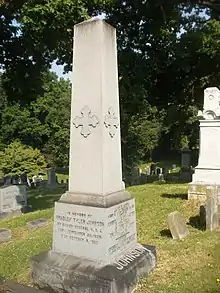 Monument for General Bradley T. Johnson, Confederate States Army
Monument for General Bradley T. Johnson, Confederate States Army Confederate Hill during Confederate Memorial Day, 2012
Confederate Hill during Confederate Memorial Day, 2012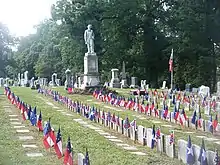 Confederate memorial and graves, Confederate Memorial Day, 2 June 2012
Confederate memorial and graves, Confederate Memorial Day, 2 June 2012 One of nearly 600 Confederate soldiers to receive a new marker
One of nearly 600 Confederate soldiers to receive a new marker Bonaparte Monument
Bonaparte Monument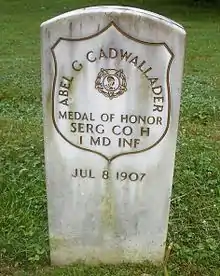 Abel Cadwallader, Union soldier and Medal of Honor recipient
Abel Cadwallader, Union soldier and Medal of Honor recipient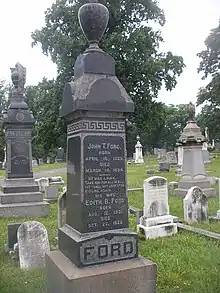 John T. Ford monument
John T. Ford monument
References
- ↑ Laura Rice. Maryland History in Prints 1743–1900. p. 189.
- 1 2 3 Marsha Wight Wise (2009). Baltimore Neighborhoods. Arcadia Publishing. p. 92. ISBN 978-0-7385-5290-3.
- 1 2 "Baltimore Neighborhoods – Irvington". City of Baltimore. Archived from the original on August 19, 2007. Retrieved December 6, 2008.
- ↑ "Home – Service Corporation International". www.sci-corp.com. Retrieved 2016-03-02.
- ↑ "Chain buying Loudon Park Cemetery Local owners also selling Druid Ridge". tribunedigital-baltimoresun. Retrieved 2016-03-02.
- ↑ "SCI Buys Stewart Enterprises". Archived from the original on 2016-03-07. Retrieved 2016-03-02.
- ↑ "Adopt a Confederate". Archived from the original on 26 June 2012. Retrieved 12 June 2012.
- ↑ "Charles J. Baker". The Baltimore Sun. 1894-09-26. p. 8. Retrieved 2022-09-04 – via Newspapers.com.

- ↑ "James A. Gary Funeral Marked By Simplicity". The Baltimore Sun. 1920-11-03. p. 9. Retrieved 2023-04-02 – via Newspapers.com.

- ↑ "Kummer". The Baltimore Sun. 1943-11-24. p. 20. Retrieved 2023-01-18 – via Newspapers.com.

- ↑ "O'Neill". The Baltimore Sun. 1966-06-03. p. C16. Retrieved 2022-12-23 – via Newspapers.com.

- ↑ "J. Smith Orrick Rites To Be Conducted". The Baltimore Sun. 1930-02-28. p. 5. Retrieved 2023-03-26 – via Newspapers.com.

- ↑ "Who we are". Loudon Park Cemetery. Retrieved December 6, 2008.
- ↑ "Prominent Men at Funeral". The Baltimore Sun. 1918-07-25. p. 14. Retrieved 2022-12-07 – via Newspapers.com.

- ↑ "Bishop A. W. Wilson Dies After Journey". The Evening Sun. 1916-11-21. p. 16. Retrieved 2022-12-03 – via Newspapers.com.

- ↑ "National Register Information System". National Register of Historic Places. National Park Service. April 15, 2008.